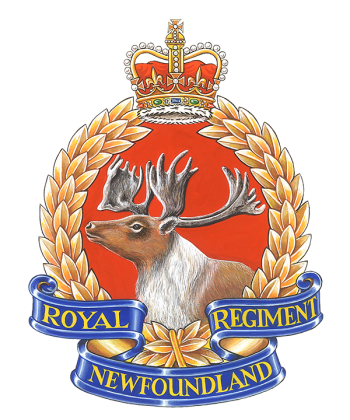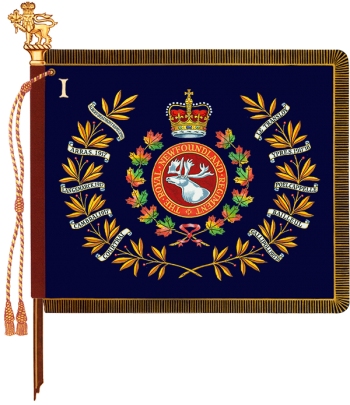Royal Newfoundland Regiment, Canadian Army: Difference between revisions
Knorrepoes (talk | contribs) m (Text replacement - "{{media}}" to "") |
No edit summary |
||
| (5 intermediate revisions by one other user not shown) | |||
| Line 1: | Line 1: | ||
{| class="wikitable" | |||
|- style="vertical-align:top;" | |||
|[[File:{{PAGENAME}}.png|center|350 px|alt=Blason de {{PAGENAME}}/Arms (crest) of {{PAGENAME}}]] | |||
|[[File:{{PAGENAME}}2.png|center|350 px|alt=Blason de {{PAGENAME}}/Arms (crest) of {{PAGENAME}}]] | |||
|<center>''' {{uc:{{PAGENAME}}}} '''</center><br> | |||
{| | '''Country''': Canada [[File:canada.jpg|60 px|right]]<br><br><br> | ||
|} | |||
| | |||
{| class="wikitable" | |||
|+Official blazon | |||
|- | |||
|'''French''' | |||
|Blazon wanted | |||
|- | |||
|'''English''' | |||
|Badge: Gules a caribou’s head and neck proper all within a wreath of laurel Or ensigned by the Royal Crown proper and set on a scroll Azure inscribed ROYAL NEWFOUNDLAND REGIMENT in letters Or. | |||
|} | |} | ||
===Origin/meaning=== | ===Origin/meaning=== | ||
The Crown represents service to the Sovereign. The laurel wreath, which symbolizes excellence and achievement, dates back to competitions and combat in ancient Greek times. The caribou head is based on the badge of The Royal Newfoundland Regiment of the First World War and which itself was copied from that of the Newfoundland Highlanders, a para-military cadet corps formed in 1907. The claret background was one of the First World War regiment’s livery colours, the other being white. “ROYAL NEWFOUNDLAND REGIMENT” is a form of the regimental title. | The Crown represents service to the Sovereign. The laurel wreath, which symbolizes excellence and achievement, dates back to competitions and combat in ancient Greek times. The caribou head is based on the badge of The Royal Newfoundland Regiment of the First World War and which itself was copied from that of the Newfoundland Highlanders, a para-military cadet corps formed in 1907. The claret background was one of the First World War regiment’s livery colours, the other being white. “ROYAL NEWFOUNDLAND REGIMENT” is a form of the regimental title. | ||
The Blazon of the | The Blazon of the badge was confirmed by the Canadian Heraldic Authority on April 15, 2008. | ||
[[Literature]]:Images from https://www.canada.ca/en/services/defence/caf/military-identity-system/ | |||
{{ca}} | |||
{{media}} | |||
[[Category:Military heraldry of Canada]] | [[Category:Military heraldry of Canada]] | ||
[[Category:Army heraldry]] | [[Category:Army heraldry]] | ||
[[Category:Granted 2008]] | [[Category:Granted 2008]] | ||
Latest revision as of 12:38, 19 August 2024
Country: Canada |
| French | Blazon wanted |
| English | Badge: Gules a caribou’s head and neck proper all within a wreath of laurel Or ensigned by the Royal Crown proper and set on a scroll Azure inscribed ROYAL NEWFOUNDLAND REGIMENT in letters Or. |
Origin/meaning
The Crown represents service to the Sovereign. The laurel wreath, which symbolizes excellence and achievement, dates back to competitions and combat in ancient Greek times. The caribou head is based on the badge of The Royal Newfoundland Regiment of the First World War and which itself was copied from that of the Newfoundland Highlanders, a para-military cadet corps formed in 1907. The claret background was one of the First World War regiment’s livery colours, the other being white. “ROYAL NEWFOUNDLAND REGIMENT” is a form of the regimental title.
The Blazon of the badge was confirmed by the Canadian Heraldic Authority on April 15, 2008.
Literature:Images from https://www.canada.ca/en/services/defence/caf/military-identity-system/
| Heraldry of the World |
| Canada heraldry portal Civic heraldry of Canada Armorial Canadienne |
|
Contact and Support
Partners:
Your logo here ?
Contact us
© since 1995, Heraldry of the World, Ralf Hartemink 
Index of the site














